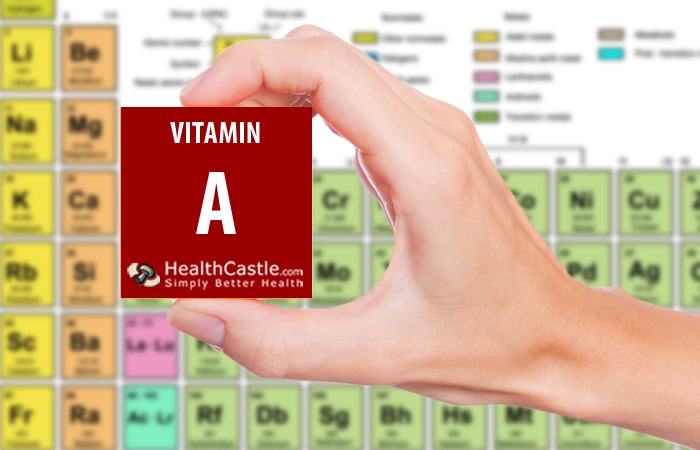
Written By: Carolyn Berry, RD
Title: Registered Dietitian
Alumni: University of British Columbia
Last Updated on:


Vitamin A is a fat-soluble vitamin that is stored in the liver. Vitamin A comes mainly from animal food sources, but we can also make it from compounds called carotenoids found in plant foods. The most famous carotenoid is beta-carotene. Other names for Vitamin A include retinol, retinal, and retinoic acid.
Table of Contents
The Dietary Reference Intakes (DRI) for Vitamin A are shown below:
| Age Group | Recommended Dietary Allowance (RDA) per Day | Tolerable Upper Intake Level (UL) per Day |
| Adults | ||
| 19 to 50 years | 900 mcg RAE male 700 mcg RAE female | 3,000 mcg RAE |
| 51 to 70 years | 900 mcg RAE male 700 mcg RAE female | 3,000 mcg RAE |
| 71 years and up | 900 mcg RAE male 700 mcg RAE female | 3,000 mcg RAE |
| Kids and Youth | ||
| 1 to 3 years | 300 mcg RAE | 600 mcg RAE |
| 4 to 8 years | 400 mcg RAE | 900 mcg RAE |
| 9 to 13 years | 600 mcg RAE | 1,700 mcg RAE |
| 14 to 18 years | 900 mcg RAE male 700 mcg RAE female | 2,800 mcg RAE |
| Special Considerations | ||
| Pregnant or lactating women 14 to 18 years | 750 mcg RAE pregnancy 1,200 mcg RAE lactating | 2,800 mcg RAE |
| Pregnant or lactating women 19 to 50 years | 770 mcg RAE pregnancy 1,300 mcg RAE lactating | 3,000 mcg RAE |
High intakes of preformed Vitamin A in pregnant women can cause birth defects. It is recommended that pregnant women not take Vitamin A supplements and limit their intake of liver.
Vitamin A is important for maintaining normal vision, especially in low light, and for keeping our skin, eyes, teeth, skeletal and soft tissue, and immune system healthy. Vitamin A is also known as retinol because it produces the pigments in the retina of the eye. It also plays a role in reproduction and helps the heart, kidneys, lungs, and other organs to work properly.
Because Vitamin A is fat soluble, the body stores excess amounts, mainly in the liver. As a result, high levels can accumulate and cause vitamin A toxicity. Consuming large amounts of beta-carotene can cause pigments in the skin to turn yellow-orange, but this condition is harmless.
Two different types of Vitamin A are found in food. Preformed Vitamin A is found in animal products such as meat, fish, poultry, and dairy foods. Pro-vitamin A is found in plant-based foods such as fruits and vegetables. The most common type of Pro-vitamin A is beta-carotene. Health Canada recommends eating one dark green and one orange vegetable or fruit each day.
| Food | Vitamin A per serving |
| Animal sources (Vitamin A) | |
| Beef liver, 3 oz | 6582 mcg RAE |
| Eel, baked, 2.5 oz | 853 mcg RAE |
| Herring, pickled, 3 oz | 219 mcg RAE |
| Cheese, goat, hard, 1.5 oz | 243 mcg RAE |
| Milk, skim, 1%, 2%, 1 cup | 149 mcg RAE |
| Salmon, 2.5 oz | 112 mcg RAE |
| Egg, 1 large | 70 mcg RAE |
| Plant sources (carotenoids) | |
| Sweet potato, baked in skin, 1 medium | 1096 mcg RAE |
| Pumpkin, canned, ½ cup | 1007 mcg RAE |
| Squash, butternut, cooked, ½ cup | 572 mcg RAE |
| Spinach, cooked, ½ cup | 472 mcg RAE |
| Carrots, raw, ½ cup | 459 mcg RAE |
| Kale, raw, chopped, 1 cup | 335 mcg RAE |
| Apricots, dried, 1/4 cup | 191 mcg RAE |
| Cantaloupe, raw, ½ cup | 135 mcg RAE |
In the United States: The daily value (DV) for Vitamin A is 900 mcg RAE. On food labels, Vitamin A is measured in International Units (IU), not mcg RAE. Converting between IU and mcg RAE is not straightforward. A varied diet with 900 mcg RAE of Vitamin A, for example, provides between 3,000 and 36,000 IU of Vitamin A depending on the foods consumed.
In Canada: The daily value for Vitamin A is 1000 mcg RAE, which is slightly higher than the DRI level for adults. Using the same example, a ½ cup serving of raw carrots that provides 459 mcg RAE of Vitamin A would have 46% of the DV for Vitamin A.
Nutrient Interactions
Zinc: Zinc is necessary for the absorption and utilization of Vitamin A
Alumni: University of British Columbia – Carolyn Berry is a Vancouver-based Registered Dietitian, self-proclaimed foodie, marathon runner, and owner of Berry Nourished. Carolyn works in a variety of areas including clinical nutrition, outpatient counselling at Medisys Preventive Health Clinic, as a nutrition tour leader with Save-On-Foods, and in the media, including segments on CBC Television, CKNW and Spice Radio. Through informative and practical nutrition advice and her food-first approach to health, Carolyn fulfills her passion to empower others with knowledge about nutrition so that they can make the best decisions to improve their health. She strongly believes that food should be both healthful and delicious.
beta-carotene, micronutrient - vitamins, vitamin a, vitamins, vitamins - minerals